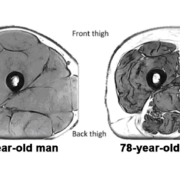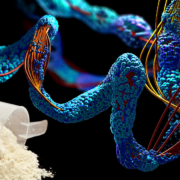Can We Prevent Sarcopenia?
Based on the research presented in Thursday’s Memo, the earlier we address the possibility that sarcopenia will affect us, the more likely we’ll succeed (1). I use fudgy words such as “likely” because we don’t know for sure, but based on the current status of research, here’s what we can do to prevent sarcopenia.
Use It or Lose It
In the study I talked about Thursday, the men who exercised regularly had a lower rate of decline in muscle function. The researchers speculate that chronic exercise helps preserve the motor units, thus preserving the ability of the nerve cells to send out nerve fibers to attach to muscle fibers.
That’s all well and good, but how can we make sure that we preserve the potential and perhaps increase our motor unit activity if we’ve lost some? Research shows that weight training will help. In several studies, resistance training increased muscle strength in the elderly; strength will improve balance and quality of life.
What kind of exercise will work best? It seems to be high intensity exercise. In a study on elderly mice, high intensity interval training (HIIT) increased the muscle mass, muscle fibers, and the number of mitochondria (2). This was a small study and it was on rodents, so the application to humans isn’t assured. To me, it means use your muscles as you mean to keep using them. The harder you exercise within your physical limitations, the better.
Focus on Protein
Retaining muscle mass is not only about exercise. For some reason, as we get older, we decrease our protein intake, but research shows that increasing protein intake can help retain muscle mass. If you don’t have protein in muscle cells, retaining or adding connections to those cells won’t matter much.
How much protein should people try to get? The current recommendation is 0.8 grams per kilogram body weight per day or a third of a gram per pound body weight; someone who weighs 200 pounds would need about 66 grams of protein per day. But research shows that bumping that up to 1.1 grams per kilogram body weight or a half gram per pound may be better as we get older. That’s 100 grams for a 200-pound person (3). That’s easy for even those who are math-challenged: whatever your goal weight, divide by 2, and that’s your daily goal for grams of protein.
It also seems better to stretch protein intake out throughout the day rather than a big slug at one time. Balanced intake will produce a sustained level of amino acids available for muscle repair throughout the day.
The research is far from complete in this area but it seems that as we age, our protein needs revert to when we were younger: we need more of it.
The Bottom Line
Sarcopenia can result in loss of strength and mass, but more important is the loss of quality of life. We don’t think balance while standing or moving is important until we fall; we don’t think brute strength is important until we need to move something and can’t. This week’s Memos give you an idea of how to prevent and perhaps improve nerve and muscle function.
Don’t think this is for only retirees; once you hit 40, it’s a downward trend. Starting early may help minimize the decline. One thing is clear: if you expect to be mobile when you get older, you need to work on it earlier rather than later.
What are you prepared to do today?
Dr. Chet
References:
1. J Physiol. 2018 Mar 11. doi: 10.1113/JP275520.
2. J Gerontol A Biol Sci Med Sci. 2018 Mar 14;73(4):429-437.
3. Nutrients 2018, 10, 360; doi:10.3390/nu10030360.









